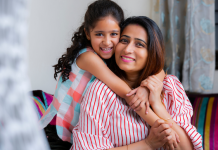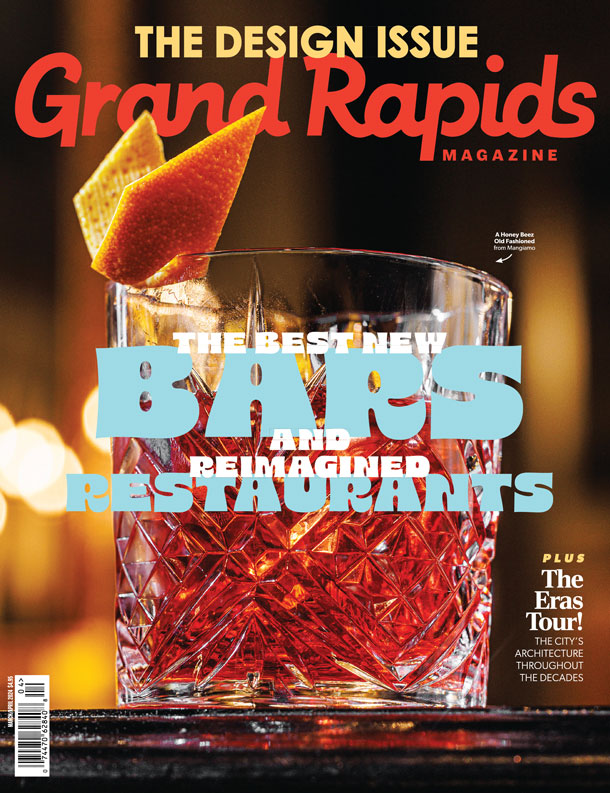Sally Keiser, the founder of Sally Ann bags, has a mission: She wants people to care about where their fashions come from, who makes them and how they are made. From handbags, backpacks, clutches and satchels, this maker’s bespoke products are made in Grand Rapids with love, a lot of time and with Mother Earth in mind.
GR|MAG: How did you get started doing this? What’s your inspiration?
SK: I’ve been sewing since I was a kid, around 7 or 8. I grew up around sewing and in college, I was making iPod cases. After college, I started the Sally Ann handbags company in 2008. I’ve been doing it ever since and made a bit of clothing and apparel too but went back to handbags because I love the process of putting them together.
GR|MAG: Let’s talk sustainable fashion. Why is that important?
SK: I grew up wearing the clothes my mom made. She cut down her clothes to make us stuff. Her jeans became little kid overalls. I loved seeing how she could turn things into something else. It reminds me when I was making tote bags out of vintage t-shirts, it’s unique and eco-friendly and the t-shirts were something I could source. It’s important to not support companies that don’t have good labor or good waste practices. It’s about fair labor and being fair to the environment.

GR|MAG: You make a lot of different bags. What’s popular right now?
SK: Backpacks are the most popular right now and they’re made to look pleasing to the eyes. It’s my favorite bag I’ve ever made. They convert from an over the shoulder bag to a backpack. With the backpack—and being a parent—I can carry everything in it and it’s out of my hands and on my back and they’re a dressier statement piece.
With the clutches, I can use scrap pieces to make those like smaller styles. On the main page of clutches, there’s a pink one made from Saks Fifth Avenue leather pants I bought at the Cascade Goodwill. I even started making some festival size handbags with a shoulder strap. The thing about handbags is that they’re so versatile. There are so many different occasions and everyday uses.
GR|MAG: How does the custom handbag process work?
SK: Most of my business is custom orders and the bags take a while to create. I make a bag and photograph it then it goes in the made to order section. I make a couple of each color combination, then it’s made to order, and they can purchase that and customize it and fit it to their needs like sending in special fabric for the interior or ordering a colored strap. The client/maker relationship is important. You are supporting a small company and you get exactly what you want.
GR|MAG: Let’s talk fabric. Where do you get it? You seem to have a lot of different designs?
SK: This is the great part, moving to West Michigan and furniture city means I get a lot of designer remnants and upholstery fabrics from a place in Holland. The pieces might be from Herman Miller or Steelcase. I’ve grabbed upholstery fabric on the roll. A friend sent me vintage silk curtains that I’m currently lining bags with right now. I’ve made bags out of military uniforms—really, anything that can go through my sewing machine I can make a handbag from.
I’m also working on some hand-dyed leather bags from deer hides and that’s fun because it’s 100 percent made in Michigan. It’s a little bit of everything and generally environmentally-friendly the way I source it.
GR|MAG: Why is it important that people know where their bags come from and how they are made? Why bring the consumer along on this process?
SK: Slavery is still in the world. There’s a lot of indentured servitude in the factories making our clothing and I wanted to do something about it. I can help in the way I purchase for my family and by making people passionate about it themselves. They know and see my face and I made their bag. Know where your clothing comes from. People are so passionate about their food and eating organic, but their clothing might be made by people working in awful conditions.
The world is being polluted by so many chemicals and your $2 shirt comes with a much higher price tag. For five years I only shopped second hand or artisan made—nothing new was my vow. I bought secondhand clothes and tailored them to fit and showed the process on my blog. You can make a difference by hosting a clothing swap or shopping Goodwill or buying from someone that’s making things locally.
GR|MAG: What does it mean to be a maker in the world today?
SK: I don’t think I could have another job. People get to carry a little bit of my artistry with them each day. My hands are making things people use and care about and it makes their lives easier. Many of my clients will purchase a second or third bag. It makes me do a little dance knowing that by making things I have a connection with people. It’s bringing us back to the days when everyone had a shoe guy, somebody that made their hats—it’s those relationships with people that change the way we interact with each other, when we care about where things come from.
Find out more about Sally Ann bags. Handbags can also be found at Wealthy Studios, across from Rowster Coffee, occasionally at the Fulton Street Artisan Market and at MADE MARKET on June 30 at Clearwater Place.
*Photos by Andrea Monk








Facebook Comments